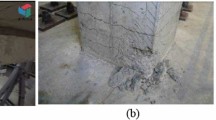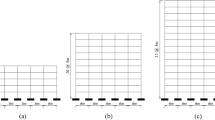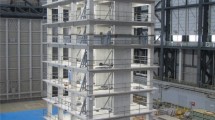Abstract
This paper aims to summarize the findings of a comprehensive study on the correlation of displacement and deformation demands estimated using various code-compliant nonlinear modeling approaches commonly used in real-life performance-based seismic design and assessment applications, with experimental results obtained from the full-scale shake table tests on the 10-story reinforced concrete building performed at the E-defense testing facility in 2015. Nonlinear response history analysis results obtained using ASCE-41 and Turkish Building Earthquake Code model configurations with the lumped plasticity modeling approach adopted for beams and columns, as well as an additional configuration adopting the distributed plasticity approach, were compared with test measurements. Analysis sets were also conducted to evaluate the sensitivity of the analytical predictions to specific modeling assumptions that incorporate varying degrees of uncertainty, including consideration of beam effective flange widths, modeling of the floor slabs, adopting a tensile strength for concrete, selecting alternative effective shear moduli for structural walls, consideration of the vertical component of the ground motion, and selection of the damping ratio. Analysis results were compared with experimental measurements in terms of various global displacement and local deformation demands on the structure, including story displacement time-histories, peak interstory drift ratios, flexural and shear deformations on structural walls, and flexural deformations on beams and columns. The relative effectiveness of different methodologies and assumptions in replicating the experimentally-measured deformation demands on the test building are discussed in detail. Limitations of the adopted modeling approaches in simulating salient experimentally-observed response characteristics of the building are also identified.





















Similar content being viewed by others
Data availability
The datasets generated during and/or analyzed during the current study are available from the corresponding author on reasonable request.
References
Alwaeli W, Mwafy A, Pilakoutas K, Guadagnini M (2017) Multi-level nonlinear modeling verification scheme of RC high-rise wall buildings. Bull Earthq Eng 15:2035–2053. https://doi.org/10.1007/s10518-016-0056-8
American Society of Civil Engineers (2017) Seismic evaluation and retrofit of existing buildings (ASCE/SEI 41-17)
Applied Technology Council (2010) Modeling and acceptance criteria for seismic design and analysis of tall buildings (PEER/ATC72-1)
Architectural Institute of Japan (2010) AIJ Standard for Structural Calculation of Steel Reinforced Concrete Structures (in Japanese)
Bedirhanoglu I, Ilki A, Pujol S, Kumbasar N (2010) Behavior of deficient joints with plain bars and low-strength concrete. ACI Struct J 107:300–310. https://doi.org/10.14359/51663695
Belarbi A, Hsu TTC (1994) Constitutive laws of concrete in tension and reinforcing bars stiffened by concrete. ACI Struct J 91:465–474. https://doi.org/10.14359/4154
Biskinis D, Fardis MN (2010) Deformations at flexural yielding of members with continuous or lap-spliced bars. Struct Concr 11:127–138. https://doi.org/10.1680/stco.2010.11.3.127
Bonet JL, Romero ML, Miguel PF (2011) Effective flexural stiffness of slender reinforced concrete columns under axial forces and biaxial bending. Eng Struct 33:881–893. https://doi.org/10.1016/j.engstruct.2010.12.009
Chang GA, Mander JB (1994) Seismic energy based fatigue damage analysis of bridge columns : part 1—evaluation of seismic capacity. NCEER Technical Report No. NCEER-94-0006. Bufalo, USA
Comert M, Demir C, Ates AO, Orakcal K, Ilki A (2017) Seismic performance of three-storey full-scale sub-standard reinforced concrete buildings. Bull Earthq Eng 15:3293–3320. https://doi.org/10.1007/s10518-016-0023-4
Deger ZT, Yang TY, Wallace JW, Moehle J (2015) Seismic performance of reinforced concrete core wall buildings with and without moment resisting frames. Struct Des Tall Special Build 24:477–490. https://doi.org/10.1002/tal.1175
Dhakal RP, Maekawa K (2002) Modeling for postyield buckling of reinforcement. J Struct Eng 128:1139–1147. https://doi.org/10.1061/(ASCE)0733-9445(2002)128:9(1139)
Disaster and Emergency Management Presidency of Turkey (2018) Turkish Building Earthquake Code, Specifications for Design of Buildings under Earthquake Effects
Elwood KJ, Eberhard MO (2009) Effective stiffness of reinforced concrete columns. ACI Struct J 106:476–484. https://doi.org/10.14359/56613
European Committee for Standardization (2005) Eurocode 8: design of structures for earthquake resistance—Part 3: Assessment and retrofitting of buildings,
Fajfar P (2018) Analysis in seismic provisions for buildings: past, present and future. Bull Earthq Eng 16:2567–2608. https://doi.org/10.1007/s10518-017-0290-8
Fischinger M, Isaković T, Kolozvari K, Wallace J (2019) Guest editorial: Nonlinear modelling of reinforced concrete structural walls. Bull Earthq Eng 17:6359–6368. https://doi.org/10.1007/s10518-019-00715-z
Ghannoum WM, Moehle JP (2012) Dynamic collapse analysis of a concrete frame sustaining column axial failures. ACI Struct J 109:403–412. https://doi.org/10.14359/51683754
Gogus A (2010) Structural wall systems—nonlinear modeling and collapse assessment of shear walls and slab-column frames. Dissertation, University of California
Gremer N, Adam C, Medina RA, Moschen L (2019) Vertical peak floor accelerations of elastic moment-resisting steel frames. Bull Earthq Eng 17:3233–3254. https://doi.org/10.1007/s10518-019-00576-6
Haselton CB, Liel AB, Taylor-Lange SC, Deierlein GG (2016) Calibration of reinforced concrete beam-columns for simulating seismic response to collapse. ACI Struct J 113:1141–1152. https://doi.org/10.14359/51689245
Ibarra LF, Medina RA, Krawinkler H (2005) Hysteretic models that incorporate strength and stiffness deterioration. Earthq Eng Struct Dyn 34:1489–1511. https://doi.org/10.1002/eqe.495
Ministry of Land, Infrastructure, Transport, and Tourism of Japan (2007) Technological Standard Related to Structures of Buildings (in Japanese)
Kabeyasawa T, Hiraishi H (1998) Tests and analyses of high strength reinforced concrete shear walls in Japan. ACI Symp Publ 176:281–310. https://doi.org/10.14359/5904
Kabeyasawa T, Kabeyasawa T, Fukuyama H (2017) Effects of floor slabs on the flexural strength of beams in reinforced concrete buildings. Bull N Z Soc Earthq Eng 50:517–526. https://doi.org/10.5459/bnzsee.50.4.517-526
Kajiwara K, Tosauchi Y, Kang J, Fukuyama K, Sato E, Inoue T, Kabeyasawa T, Shiohara H, Nagae T, Kabeyasawa T, Fukuyama H, Mukai T (2021) Shaking-table tests of a full-scale ten-story reinforced-concrete building (FY2015). Phase I: Free-standing system with base sliding and uplifting. Eng Struct 233:111848. https://doi.org/10.1016/j.engstruct.2020.111848
Kajiwara K, Tosauchi Y, Sato E, Fukuyama K, Inoue T, Shiohara H, Kabeyasawa T, Nagae T, Fukuyama H, Kabeyasawa T, Mukai T (2017). 2015 Three-dimensional Shaking table test of a 10-story reinforced concrete building on the E-defense part 1 : overview and specimen design of the base slip and base fixed tests. Procs. of 16th World conference on earthquake engineering, Santiago, Chile
Kim Y, Kabeyasawa T, Matsumori T, Kabeyasawa T (2012) Numerical study of a full-scale six-story reinforced concrete wall-frame structure tested at E-Defense. Earthq Eng Struct Dyn 41:1217–1239. https://doi.org/10.1002/eqe.1179
Kolozvari K, Arteta C, Fischinger M, Gavridou S, Hube M, Isakovic T, Lowes L, Orakcal K, Vasquez J, Wallace JW (2018) Comparative study on state-of-the-art macroscopic models for planar reinforced concrete walls. ACI Struct J 115:1637–1657. https://doi.org/10.14359/51710835
Kolozvari K, Biscombe L, Dashti F, Dhakal RP, Gogus A, Gullu MF, Henry RS, Massone LM, Orakcal K, Rojas F, Shegay A, Wallace J (2019) State-of-the-art in nonlinear finite element modeling of isolated planar reinforced concrete walls. Eng Struct 194:46–65. https://doi.org/10.1016/j.engstruct.2019.04.097
Kumbasar N (2015) Bending stiffness of reinforced concrete sections. Teknik Dergi/Tech J Turk Chamber Civ Eng 26:7265–7278
Malomo D, Mehrotra A, DeJong MJ (2021) Distinct element modeling of the dynamic response of a rocking podium tested on a shake table. Earthq Eng Struct Dyn 50:1469–1475. https://doi.org/10.1002/eqe.3404
Melek M, Darama H, Gogus A, Kang T (2012) Effects of modeling of RC flat slabs on nonlinear response of high rise building systems. Procs. of 15th World Conference on Earthquake Engineering, Lisbon, Portugal
Moehle J, Bozorgnia Y, Jayaram N, Jones P, Rahnama M, Shome N, Tuna Z, Wallace J, Yang T, Zareian F (2011) Case studies of the seismic performance of tall buildings designed by alternative means—Task 12 Report for the Tall Buildings Initiative. Pacific Earthquake Engineering Research Center
Perform3D V.7.0.0. (2018). Nonlinear Analysis and Performance Assessment for 3D Structures, Computers and Structures Inc
Papazoglou AJ, Elnashai AS (1996) Analytical and field evidence of the damaging effect of vertical earthquake ground motion. Earthq Eng Struct Dyn 25:1109–1137. https://doi.org/10.1002/(SICI)1096-9845(199610)25:10%3c1109::AID-EQE604%3e3.0.CO;2-0
Powell GH (2007). Detailed Example of a Tall Shear Wall Building Using CSI’s Perform 3D Nonlinear Dynamic Analysis: Nonlinear Modeling, Analysis and Performance Assessment for Earthquake Loads. Computers and Structurs Inc
Saatcioglu M, Razvi SR (1992) Strength and ductility of confined concrete. J Struct Eng 118:1590–1607. https://doi.org/10.1061/(ASCE)0733-9445(1992)118:6(1590)
Sato E, Tosauchi Y, Fukuyama K, Inoue T, Kajiwara K, Shiohara H, Kabeyasawa T, Nagae T, Fukuyama H, Kabeyasawa T, Mukai T (2017) 2015 Three-dimensional shaking table test of a 10-story reinforced concrete building on the E-defense part 2: specimen fabrication and construction, test procedure, and instrumentation program. Procs. of 16th World Conference on Earthquake Engineering, Santiago, Chile
Sousa R, Eroglu T, Kazantzidou D, Kohrangi M, Sousa L, Nascimbene R, Pinho R (2012) Effect of different modelling assumptions on the seismic response of rc structures. Procs. of 15th World Conference on Earthquake Engineering, Lisbon, Portugal
Terzioglu T, Orakcal K, Massone LM (2018) Cyclic lateral load behavior of squat reinforced concrete walls. Eng Struct 160:147–160. https://doi.org/10.1016/j.engstruct.2018.01.024
Thomsen JH, Wallace JW (1995) Displacement-based design of reinforced concrete structural walls: an experimental investigation of walls with rectangular and T-shaped cross-sections. Report no CU/CEE-95-06, Department of Civil Engineering, Clarkson University
Tian Y, Liu X, George S (2020) Effects of vertical ground motion on seismic performance of reinforced concrete flat-plate buildings. J Struct Eng 146:04020258. https://doi.org/10.1061/(ASCE)ST.1943-541X.0002840
Tosauchi Y, Sato E, Fukuyama K, Inoue T, Kajiwara K, Shiohara H, Kabeyasawa T, Nagae T, Fukuyama H, Kabeyasawa T, Mukai T (2017) 2015 Three-dimensional Shaking Table Test of a 10-story Reinforced Concrete Building on the E-Defense Part 3: Base Slip and Base Fixed Test Results. Procs. of 16th World Conference on Earthquake Engineering, Santiago, Chile
Tran TA, Wallace JW (2015) Cyclic testing of moderate-aspect-ratio reinforced concrete structural walls. ACI Struct J 112:653–665
Turkish Standards Institute (2000) Requirements for Design and Construction of Reinforced Concrete Structures (TS500)
Ugalde D, Lopez-Garcia D, Parra PF (2020) Fragility-based analysis of the influence of effective stiffness of reinforced concrete members in shear wall buildings. Bull Earthq Eng 18:2061–2082. https://doi.org/10.1007/s10518-020-00786-3
Yassin MHM (1994) Nonlinear Analysis of Prestressed Concrete Structures Under Monotonic and Cyclic Loads, Dissertation, University of California
Zekioglu A, Willford M, Jin L, Melek M (2007) Case study using the Los Angeles tall buildings structural design council guidelines: 40-storey concrete core wall building. Struct Des Tall Special Build 16:583–597. https://doi.org/10.1002/tal.434
Funding
The authors declare that no funds, grants, or other support were received during the preparation of this manuscript.
Author information
Authors and Affiliations
Contributions
All readers read and approved the final manuscript.
Corresponding author
Ethics declarations
Conflict of interest
The authors have no relevant financial or non-financial interests to disclose.
Additional information
Publisher's Note
Springer Nature remains neutral with regard to jurisdictional claims in published maps and institutional affiliations.
Rights and permissions
Springer Nature or its licensor (e.g. a society or other partner) holds exclusive rights to this article under a publishing agreement with the author(s) or other rightsholder(s); author self-archiving of the accepted manuscript version of this article is solely governed by the terms of such publishing agreement and applicable law.
About this article
Cite this article
Tura, C., Aydın, S., Yazgan, U. et al. Critical issues in nonlinear modeling of reinforced concrete buildings: code-compliant modeling approaches and the 2015 E-defense shake table tests on a full-scale 10-story building. Bull Earthquake Eng 22, 329–364 (2024). https://doi.org/10.1007/s10518-023-01772-1
Received:
Accepted:
Published:
Issue Date:
DOI: https://doi.org/10.1007/s10518-023-01772-1




